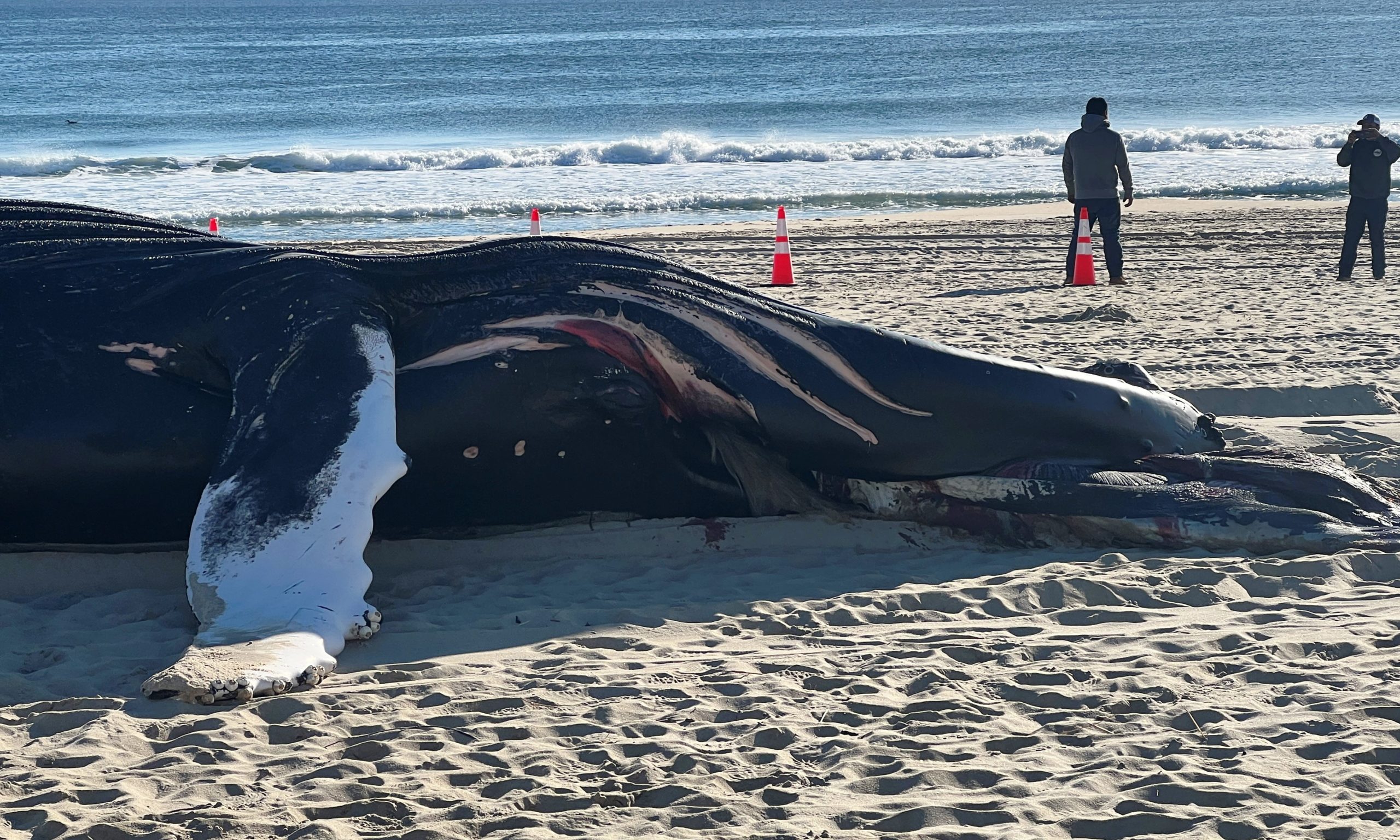
On Monday, February 13, the ninth dead whale since December to wash up dead along the New Jersey, New York coast came ashore along the beach at Manasquan in Monmouth County. According to Andrea Gomez, Communications Specialist at NOAA Fisheries, the humpback was in a state of advanced decomposition when it washed up, which she said limited the necropsy though tissue samples were taken and will be sent out for analysis.
“The whale was in good body condition and there were no obvious signs of external trauma,” Gomez said, adding “However, the internal examination showed evidence of vessel strike.”
In her email to The Fisherman Magazine on February 15 following our weekly video forecast from the beach at Manasquan, Gomez said there is not always obvious external evidence of vessel strikes, which is why internal exams are important, adding “results from the tissue analysis will help us determine if the vessel strike occurred before or after death.”
While NOAA Fisheries seems to indicate that ship strikes or entanglements are mostly to blame for the unusual marine mammal mortality events, many other members of the shore community have pointed to pre-construction testing by survey vessels involved in offshore industrial wind projects; the timing connection is, at the very least, a coincidence worth more analysis.
In response, on February 17 Congressman Jeff Van Drew (New Jersey District 2) announced that he plans on holding a hearing in South Jersey on March 16 regarding offshore wind projects being built off the coast of New Jersey, noting that a time and location will be announced in the coming weeks.
“The unknown impacts of these offshore wind projects raises serious concerns, especially after 18 whales have washed ashore near where surveying is taking place, six of which have been in New Jersey,” said Rep. Van Drew, adding “These projects will have substantial impacts on the local tourism industry, the fishing industry, and the surrounding environment.”
The congressman also announced that he will be introducing legislation that places a moratorium on all existing projects and legislation that will prohibit all future projects. As a result of these comprehensive hearings, it will determine what the best course of action will be and if additional pieces of legislation are needed.
“As Vice Chairman of the Transportation and Infrastructure Committee, I am holding these hearings in order to discover what exactly these impacts will be and to determine what additional pieces of legislation will be adequate to address the issue,” Rep. Van Drew added.
Just 24 hours after Rep. Van Drew made his announcement, three common dolphins died after they were found stranded on the bayside of Gateway National Recreation Area in Sandy Hook. According to Sheila Dean, Director at Marine Mammal Stranding Center in Brigantine in Atlantic County, the cause of the dolphin deaths is unknown, though the mammals have be sent to the state pathology lab for animals in Trenton.
Another dead humpback also washed ashore on Rockaway Beach on Long Island on the very day that Rep. Van Drew made his official hearing announcement.
At a protest rally on the boardwalk in Point Pleasant Beach on February 19, hundreds gathered to demand a moratorium on offshore wind. According to a report in the Brick Patch by reporter Karen Wall, Rep. Van Drew specifically called out at least one of the wind developers for being less than forthright. “I’ve been dealing with this for three years,” Van Drew told The Patch, saying that in his conversations with representatives of Orsted that he’s been lied to on several occasions by the Danish wind developer, including in claiming it spoke with local residents and fishermen about the project.
“They’re going to ruin our way of life at the Jersey Shore,” Van Drew said.
Also quoted in The Brick Patch article was Bonnie Brady of the Montauk Commercial Fishermen’s Association who said the testing being done by offshore wind developers is not seismic testing but sub-bottom profiling, which uses low-frequency sonar to look at 200 to 300 feet below the surface for potential sites for construction. Brady spoke at Sunday’s rally in Point and said the low-frequency sonar appears to be causing temporary deafness in the whales, affecting their ability to navigate and, in turn, resulting in vessel strikes.
The Fisherman Magazine first raised concerns about industrialize offshore windfarms in 2019 in an article titled Myth or Matter: Is Offshore Wind Blowing in Too Fast? that documented overseas research showing negative effects of electromagnetic fields from power cables on marine life.
In a report released in 2020, the Science Center for Marine Fisheries (SCEMFIS) found that the federal government “paid insufficient attention” to the total impact that offshore wind would have on the ecologically important “cold pool” of water that extends seasonally off the Atlantic Coast when it allowed wind developers to begin the process of industrial offshore wind facilities. According to SCEMFIS, any weakening of that cold pool could help generate “the most catastrophic ecological event on the continental shelf the world has ever seen.”
Read more in May 6, 2021 Editor’s Log: Big Wind Risks.